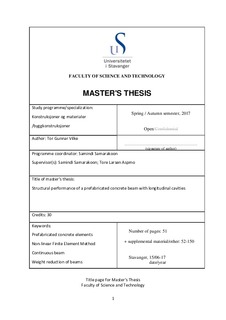| dc.description.abstract | Precast concrete elements are getting more and more popular in the construction industry. The precast elements are casted into many different shapes and sizes, which includes walls, beams, columns, slabs and more. There are many advantages of using them, although there are also many limitations. Moreover, concrete elements pass different stages such as casting, storing, transporting and disassembling. Especially the last two stages, brings several limitations regarding size and especially weight to the picture.
A specific project turned out to have some problems regarding the weight of a large continuous beam with cross-shaped (special DLB) cross section, carrying hollow decks on both corbels, created the motivation for the topic of this thesis. Many different ideas on how to reduce the weight of the beam were mentioned. Use of lightweight concrete, use pf pre-stressing beams, hollow sections, geometrical changes and many others were proposed. Inspiration from hollow decks and IB-beams created the final idea of using longitudinal cavities as a measure. Originally, the beam was designed using a Gerber system, a system which allows for splitting a continuous beam in parts. It also had transverse cavities. However, for simplicity, the original beam has been re-designed for a case without either Gerber or transverse cavities.
The beams have been designed using rules given in Eurocode 2 [1] and design guidelines given in the concrete element book [2] [3]. Also, a publication [4] regarding where the Euler-Bernoulli beam theory is valid for concrete structures has been used in the design phase. Practical design with regards to production has had a very high focus. Preliminary control and calculations for design were mostly done using simple software [5] for design of concrete structures directly towards Eurocode 2 with Norwegian annex.
Through discussion and trial & error, a design with a cavity below the neutral axis were proposed, which then maintained almost all its theoretical bending moment capacity (cracked section assumed). As the initial beam were assumed to be sufficiently constrained in the lateral direction, the shear capacity then turned out to be the main issue for design. Reduction in shear capacity introduced further limits to where the design may be used.
The initial beam cross section consists of a rectangular beam 520mm*980mm with rectangular corbels 150mm*250mm on each side starting at 350mm above the most bottom part. Space for two layers of ø32 in both top and bottom, shear rebar ø16, and corbel rebar both in the transverse ø12 and longitudinal direction. For the modified cross section, the bottom part of corbels was angled at 45 degrees. A cylindrical cavity ø300 were added and corbel rebar adjusted accordingly. Longitudinal and shear rebar were unaffected. The cavities were added at a distance equivalent to effective depth, “d”, of the cross section from the face of each support, unless the shear capacity of the cross section were violated, in which it was moved accordingly. In sum, these modifications reduced the total weight of the continuous beam by ~9%.
To study the structural behavior of the proposed beam, numerical analysis was then carried out using a non-linear finite element software (i.e. ATENA [6]) specifically aimed at concrete structures. Two models were produced for comparison, and two extra for control of shear rebar and mesh size. All the numerical results produced a way too high crack width, though all models mostly passed criteria for deflection, crushing of concrete and yielding of rebar. Comparatively, the higher range of values in the modified beam had mostly ~5-10% higher values for crack width, deflection and compressive stress in concrete.
In sum, this design approach seems to be a good measure, though the economical and other aspects have not been analyzed in detail. Further studies must be performed for a proper conclusion. | nb_NO |

